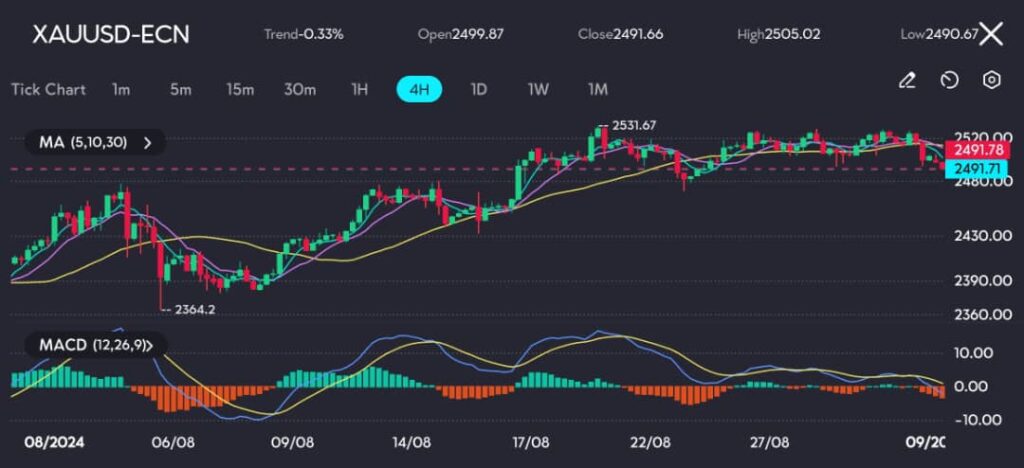Key points:
- Spot gold remained flat at $2,502.89 per ounce, while U.S. gold futures rose 0.3% to $2,535.00.
- Traders anticipate a 67% chance of a 25-basis point Fed rate cut in September, with the upcoming U.S. employment data in focus.
Gold prices held steady on Monday after a 1% decline in the previous session, as recent U.S. inflation data pointed to a smaller-than-expected interest rate cut by the Federal Reserve this month.
The precious metal, often seen as a hedge in low-interest-rate environments, faces a delicate balance as traders adjust their expectations.
Strong consumer spending dampens prospects for aggressive Fed rate cut
The latest data on U.S. consumer spending, released on Friday, showed a solid increase in July. This development argues against a more aggressive half-percentage-point rate cut by the Fed. The personal consumption expenditures (PCE) price index, a key measure of inflation, rose by 0.2% in July, aligning with expectations and following a 0.1% advance in June.

See: Gold trading at 2491.71 as seen on the VT Markets app.
Turning our view to the charts, we see that gold has seen a muted response to the growing expectations of a rate cut by the Federal Reserve at its September 17-18 meeting. The precious metal, which typically thrives in a low-interest-rate environment due to its non-yielding nature, has been hovering around the $2,500 mark. Traders are currently betting on a 67% likelihood of a 25-basis point cut, while the chances of a more aggressive 50-basis point reduction have waned to 33%.
The price action in gold, as shown in the chart, reflects this cautious sentiment. After peaking near $2,531 earlier in the month, gold has pulled back slightly, with prices consolidating just below the $2,500 level. The MACD histogram remains negative, indicating that momentum is still weak. Meanwhile, the moving averages are flattening out, suggesting a period of consolidation rather than a clear trend direction.
As the Fed’s decision date approaches, gold’s price movements are likely to be dictated by shifts in rate cut expectations. Should the Fed opt for a less aggressive cut, the metal could face downward pressure as traders reassess the outlook for the U.S. dollar and interest rates. However, any dovish surprises from the Fed could reignite bullish sentiment in the gold market.
Investors are currently turning their attention to the upcoming ADP employment data and the U.S. non-farm payroll report, both due later this week. These reports are likely to influence the Fed’s final decision on interest rates, adding a layer of uncertainty to the market.
You might be interested: Gold prices rise as Fed signals rate cut in September
Rising tensions in Israel may boost demand for safe-haven assets
On the geopolitical front, tensions in Israel have escalated following the death of six hostages in Gaza. Protests have erupted as public frustration grows over the leadership’s inability to secure a ceasefire. Such developments could further impact market sentiment, particularly in safe-haven assets like gold.
In other precious metals, spot silver edged 0.2% higher to $28.89 per ounce, platinum remained nearly steady at $926.80, and palladium rose 0.3% to $968.18.
Platinum sector faces decline amid shifting global energy trends
South Africa’s platinum mining industry continues to face challenges, with Northam Platinum CEO Paul Dunne stating on Friday that the sector has entered a phase of irreversible decline. This is largely due to low prices and weakening demand, exacerbated by the rise of battery electric vehicles. As the global shift towards cleaner energy accelerates, the traditional demand for platinum may see further erosion, impacting prices in the longer term.
As the market digests these developments, the upcoming U.S. employment data and geopolitical tensions will play crucial roles in shaping the direction of gold and other precious metals. Traders should remain cautious, considering the potential volatility in the lead-up to the Fed’s policy meeting later this month.
Start trading now — click here to create your live VT Markets account.









